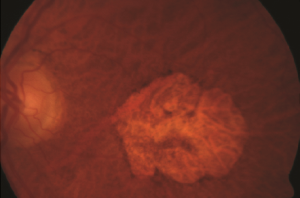
Picture provided by Pamela Weber, MD Island Retina
What is Geographic Atrophy?
Geographic atrophy (GA) is an advanced form of dry age-related macular degeneration (commonly referred to as AMD). AMD is a disease that affects part of the back of the eye called the macula.
What is the macula?
The macula is a small but important area in the center of the retina. You need the macula to clearly see details of objects in front of you, like faces and written text. A number of eye problems can affect the macula and can lead to vision loss if they are not treated.
Approximately 20% of patients with age-related macular degeneration (AMD) will develop a condition called geographic atrophy (GA). It is considered a late stage of AMD and involves chronic, progressive degeneration of regions of the retina due to cells wasting away and dying (atrophy). GA leads to central scotomas, which are blind or blurry spots in the central field of vision. These areas typically expand over time, gradually causing permanent loss of visual acuity.
The center part of your vision may not be affected at first, some people with GA may keep a small area of central vision leading to possible delays in the diagnosis of GA. GA can occur in one eye or both, but if a patient has it in one eye, they are more likely to develop it in the other as well. The condition may remain asymmetric (unequal) in the other eye for a while and progresses slowly. Sudden loss of central vision does not commonly occur with GA.
It is estimated that 1 million people in the United States have GA
Dry Macular Degeneration vs Wet Macular Degeneration
Dry Macular Degeneration is the most common form of AMD. Yellow deposits called drusen will form under your retina. Drusen will sometimes grow in size and block the flow of nutrients that nourish the retina. Once this happens retinal cells in the macular will die, leading to blurry vision. This form of macular degeneration progresses at a slower rate than wet AMD.
Wet Macular Degeneration can cause rapid and in some cases serious vision loss. Vision loss usually occurs when tiny new blood vessels grow under and into the retina. These blood vessels are abnormal blood vessels (not true blood vessels) and will often break and leak leading to a fluid build-up under the retina which leads to vision loss.

Symptoms
Sometimes there are no noticeable symptoms. Other times some will notice missing letters in a word and missing parts of people’s faces. Vision changes from GA may include:
- Central vision loss affects the middle part of your field of view- this part of your eyesight is used for nearly every task- you may notice that numbers and letters are missing while reading
- A dim or dark spot in your central or near central (side) vision.
- Difficulty in low light – if you notice difficulty reading, sewing, cooking, crafts, or seeing another person’s face.
- Not being able to distinguish colors- vision may seem dull, faded, or obstructed.
If you are experiencing any of the symptoms mentioned above please make an appointment to see your eye care professional.
Risk factors for developing geographic atrophy
Family history of AMD
Smoking
Age over 60 yrs of age
Having high blood pressure or high cholesterol or both
Caucasians have a higher rate of AMD
Being overweight
Light colored eyes
Heart disease or diabetes
Women not using menopausal hormone replacement therapy
High exposure to the sun
Poor diet- not enough fish, fruits, and green leafy vegetables
Diagnosing Geographic Atrophy
If you are 50 years or older you should have a comprehensive eye exam every year or at most two years. It’s important to keep all scheduled eye exams even if you feel you are not having any vision problems.
What you can expect at your eye appointment. Your eye care professional will conduct the following tests:
Visual acuity- this test will let the doctor know how well you see through your central vision in each eye- this test is performed by you reading the eye chart.
Dilated eye exam- eye drops will be administered to widen the pupils, thus giving the doctor a better view of the back of your eyes which include the retina and macular- the doctor is looking for changes in the macular.
If your doctor suspects GA they may order additional tests
Fundus photograph-This photograph will provide a picture of the retina and will document the number of drusen present. It will be used to compare the drusen or GA at future visits.
Optical coherence tomography (OCT) this test provides a cross-sectional image of the eye, which can show if the macula is thickened, a loss of tissue, and/or if there is fluid under the retina that may be affecting vision.
Fluorescein angiography- this is where a small amount of dye is injected into the arm and will light up the blood vessels in the eye, multiple photos are taken- these images may show new blood vessel growth in the macular and if the dye is leaking which might mean fluid is into or under the retina. This test will be used sometimes to diagnose GA but it is mostly used for wet AMD.
Visual function tests- your doctor may request additional tests to access your visual impairment.
What treatments are available for GA?
The FDA approved intravitreal pegcetacoplan (SYFOVRE; Apellis) to treat geographic atrophy (GA) secondary to age-related macular degeneration (AMD). SYFOVRE will be delivered through an injection into the vitreous, the soft gel in the middle of the eye, once every 25 to 60 days in an eye doctor’s office. The frequency of the injections will be at the doctor’s discretion. This treatment is expected to begin in March 2023.
Talk to your doctor to determine if this treatment is right for
you. Additional treatments for GA have been approved by the FDA.
If you are at risk for geographic atrophy, here are some things that you can do.
Amsler grid-can help detects early signs of retinal disease and monitors changes in vision after diagnosis. If you have dry age-related macular degeneration (AMD), it is important to monitor your vision with an Amsler grid. It is important that you do this test every day. If you notice any changes such as having trouble reading or seeing straight lines that appear wavy or broken, tell your eye
doctor right away.
Home monitoring- there are other home monitoring devices such as ForeSeeHome – this device is an early warning system for your eyes to help detect wet AMD earlier. The monitoring program includes an easy-to-use, in-home device that checks for changes in your central vision, which you may not see or notice on your own. Your eye care professional will need to order this.
Exams- It is important that you keep all scheduled eye exams. The exam will determine if you have AMD and if your condition is getting worse.
Healthy Habits-can lead to healthy eyes – quit smoking, eat healthy with lots of fruits and vegetables, especially dark green leafy vegetables, wear sunglasses and stay active (remember to talk to a doctor before starting an exercise program).
Vitamins- check with your eye care professional about which vitamins may work for you- they normally suggest the AREDS vitamins lower the risk of dry macular degeneration converting to wet macular degeneration. Talk with your health care provider and eye care professional before taking any vitamins. This is not a cure.
What can I do if I lost vision to geographic atrophy?
If you or a loved one has lost sight due to GA or wet macular degeneration, there are low-vision rehabilitation clinics that can help, or low-vision doctors can help you continue to live independently by maximizing your remaining sight.
Vision Rehabilitation provides strategies and skills along with low vision aids for living with low vision.
A low-vision specialist will help determine the right plan based on your needs. Ask your eye care professional to recommend one.
Low vision aids can include:
- Magnifying devices for reading
- Telescopic lenses for distance
- Specialized lighting and lights
- Large-print newspapers, magazines, and books
- Closed-circuit TVs that magnify a printed page on a screen
- Special computers and tablets
- Special software added to your current computer or tablet
